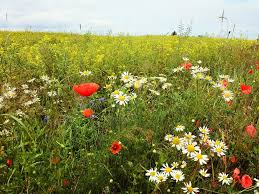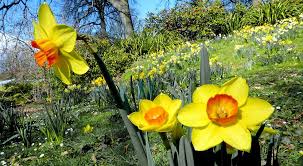
Mowing a lawn
The Royal Horticultural Society have started a campaign in recent years, to encourage people not to mow their lawns in May. Doing away with the weekly cut for one month in spring and letting the grass grow to create a better grass habitat for invertebrates, insects. This is a lordable campaign to get us all to think about our gardens more as wildlife habitats and less as ornamental outdoor spaces for just our needs,

A traditional striped cut lawn
One of the best wildlife habitats our gardens have to offer is grass and we can all do our bit to help create a variety of lawn habitats in very simple ways even in the smallest garden. Lots of people seem to assume the default best and only thing to do is to either not cut your lawn at all or to rip it all out to create a wild flower meadow. The latter being really quite difficult to achieve.

A flowering meadow
But this is not so, the best way to create as many different grass habits to suit as wider range of different insects as possible; is to have areas of grass, cut to different heights throughout the mowing season and going into the autumn and winter months.

Spring bulbs planted in a lawn
From your neat family lawn, cut every 1 to 2 weeks, ready for ball games and family picnics, to areas of grass that have spring bulbs and grow long till June. To fuzzy fringes of grass that are cut every 4 to 6 weeks to the knee high meadow you strim in August. Creating different mowing regimes and different habitats.

Daisies and dandelions in a lawn
So even if you only have one lawn, can you decide on a sweeping shape at one end that you will only cut every 4 to 6 weeks on high, so it is always ‘daisy’ length. Allowing what traditionally were considered lawn ‘weeds’ to flower makes valuable insect food and your sterile green lawn will now have a sweep of colour that will be buzzing with life,

Bee on a dandelion
A round the edges of the lawn, or under the canopies of less dense trees, consider adding spring flowering bulbs, the same space can take you though from January with crocus and snowdrops, with Daffodils and Narcissi, from early to late spring. See the September 2018 blog about nationalising bulbs. Not only will this give you a slash of colour, it will be a valuable food source for insects, but the longer grass will also act as a different habitat. Either you can cut the grass at the end of June once the bulbs have died down and then continue with a 4 to 6 week cutting or you can let the area grow long and cut down in early autumn.

Crocus late winter in a lawn
If you have grass garden paths, then cut them about every 3 weeks and on a higher cut than the main lawn, as the wear will be intensified over the narrower area, making for a greener path and yet another different grass habitat.

A long grass lawn
If you do have space in the more wild and woolly edges of your garden to let a strip of grass grow up to meadow height, this will be an invaluable habitat. You don’t need to go to the effort and expense of making a ‘wildflower meadow’. Just allow your existing grass sword to grow. Other plants from cowpalsy to docks and nettles will appear, all are valuable food souses for a range of insects. The trick is to manage things, particularly if it is a small space as some of these plants can be very invasive and over 2 or 3 years you may find you have a monoculture. So weed out by pulling as needed. For larger areas mown paths will lead the way though your meadow so you can get up close to the insect life. At the end of August, beginning of September, Strim down the meadow, you may want to leave some woodier plants up like docks through the winter. Gather the grass into stripes for about 3 weeks. Remove most of the grass piles so the grass dose not die under nether, but leave the odd pile of grass staked through the winter months till mid February as an over wintering habitat for various insects. Remove late February to make way for the new season grass growth.

Mown paths through a meadow.
I hope I have inspired you to look again at your lawn and gassy spaces in your garden and that you will decide to create different grass habitats, after all it means less mowing, so it is win win for you and the insects.
